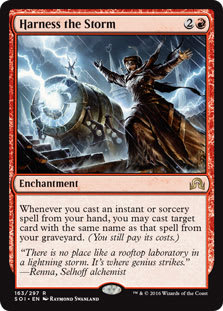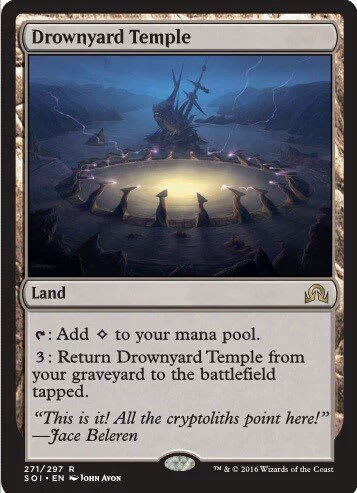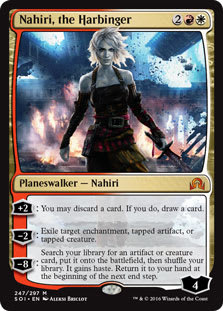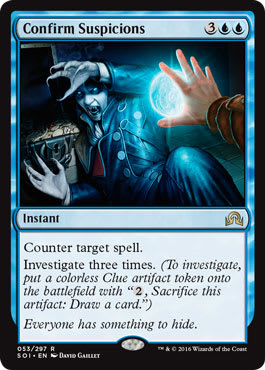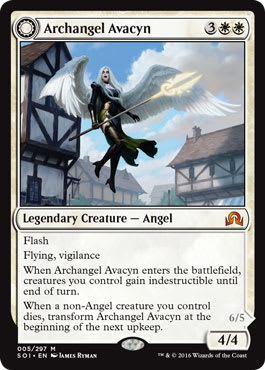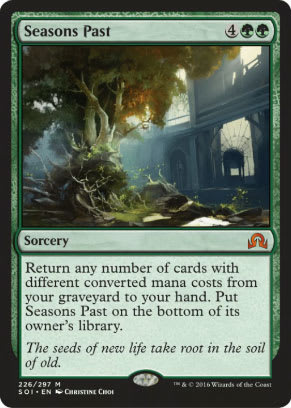Hello, folks! We’ve had some time to ponder and pore over the Shadows over Innistrad spoilers, have some prerelease fun-times, and otherwise pretty much get down tonight. After investing into the cards, which ones are the best for your next casual night? Which ones are you salivating for Commander or Pauper or multiplayer?
One of the heartbeats of Magic is the ongoing avalanche of new cards. There’s always something new, something to be explored. Are you ready?
Below are my choices for the Top 10 Cards from Shadows over Innistrad for kitchen-table Magic.
10 — Cryptolith Rite
If I still regularly played Five Color with casual players (long may the format live), I would rave about how amazing this card is for it. Five Color is a casual format with three-hundred-card decks and twenty-five cards of each color required. But it’s out of favor these days, and most folks haven’t heard of it. I still like it more than Commander, but ah well, them’s the breaks. The Rite is great at doing a lot of yeoman’s work. As someone who has loved and advocated for Citanul Hierophants here in these pages, it’s a concept I’m familiar with, and it’s going to be good. It makes a lot of mana, and it smooths your colors. Since it’s an enchantment, it typically stays in play more easily than most other nonland stuff, and it gives you a powerful ability to generate the good stuff.
9 — Harness the Storm
I love the combo and synergy potentials of this card so much that I dedicated an entire Top 10 article to it last week. Check that out! And in order to avoid not giving you your money’s worth, here’s a card that made my top twenty and was among the last to come off my list:
Not 9 — Drownyard Temple
Land destruction has always been a thing. When we get competent tools to fight it, like Darksteel Citadel or Crucible of Worlds, they create a lot of value. (Junky lands like Ghost Town were too weak to do anything, but realistic answers have always been sought after.) Drownyard Temple is a great answer. Did you destroy my land? I’ll just toss it back. It’s also great fodder for things like Dust Bowl or Infernal Tribute. Sacrifice it for an effect, and bring it back again. It’s arguably the most synergetic card in the set. Cards that mill your deck—like those with dredge or Satyr Wayfinder—are good for cards like Trade Routes, Intuition, Realms Uncharted, loot effects, discard effects, and a ton more. From a hellbent Rakdos deck that drops its hand to a powerful W/U control deck that wants to ensure its land count, to an Armageddon or Wildfire deck that would love to bring back some lands after they are killing, this thing is swimming with combo potential. It’s a great card.
8 — Nahiri, the Harbinger
To my mind, Nahiri should prove the strongest of the new ’Walkers at the kitchen table. She’s being poo-poo’d by the tournament writers elsewhere for being unsynergistic or not that powerful, and that’s fine. Whatever. For your kitchen-table needs, Nahiri should provide you a lot of value. She can discard a card to draw another, giving you solid card quality while gaining loyalty. She can exile enchantments or tapped artifacts or creatures, which is solid. Obviously, we’d love to have that ability without the tapping clause, but obviously, she’s just 4 mana to cast, not 5. Plus, she exiles, instead of destroys, which is just strong for your creature-removal needs. Her ultimate ability is fun, hard to reach, and not overpowered or so insane that people “must kill her” before she reaches that stage. She’s smooth.
7 — Confirm Suspicions
I like countering spells, and I like drawing cards. That’s why a card like Dismiss often finds its way into my decklists. For 1 more mana, you can counter something and then make a trio of Clue tokens for your efforts. Now, getting cards out of these will require an additional effort. But how often do you end your opponent’s turn and then go to untap with extra mana you could have used? Since you often leave mana free for answers in blue, you may as well have a backup plan to sacrifice Clues for cards if you don’t need to drop that Counterspell. Also note that the sheer number of artifacts hitting play, and then dying later, can really add to your deck. Forget sacrificing them for cards; gaining three artifacts for an artifact-heavy deck is money on its own. That’s enough to use Kuldotha Forgemaster or give you fuel for Goblin Welder. You can tap them for Clock of Omens. Use them to fuel a Grinding Station. Use their death triggers to make 2/2 Pincer token creatures with Summoning Station. And that’s just the beginning—you’ll find an impossible number of interactions for your Clues. This is a powerful counterspell for any control deck, and even more for an artifact-themed blue deck.
6 — Archangel Avacyn
Indestructible is nice. But it’s not as good as it used to be. Everyone is packing exiling removal now. Black has an epic-ton of exiling targeted removal—Sever the Bloodline, Gild, Silence the Believers, Oblivion Strike. We have exiling Vindicates like Utter End and Anguished Unmaking. Burn from Within? A ton of exiling countermagic? We have it in spades. So your one-turn trick with Avacyn is good, useful, and interesting; as a surprise, she may offer more than the Avacyn, Angel of Hope original. The flash is what makes her work, to my mind, and puts her on this list. Otherwise, she’d be mostly used to swing that turn without fear of losing your creatures. (You can still do that. Drop her, give your stuff indestructible, and then swing.) Assuming you aren’t playing her in an exclusively Angel deck, she’ll eventually do an Akroma and transform to her angry red side when a non-Angel of yours perishes. Everything else gets shot for a Lightning Bolt of damage, save for you and yours. That can clear out some nasty stuff all day long. And then you have your 6/5 angrier Angel, but without vigilance. Seems like a fair tradeoff to me. She’s strong.
5 — Dissension in the Ranks
This is a new combat trick, so I want to play it first, but I have extremely high hopes for this one. We’ve seen enough fight cards by now to have a great idea of how they work. You can set up the fight to your advantage. You can often get two creatures to die with the right choices. You should always be able to kill at least one blocker. I doubt your foe will block with Indomitable Ancients and Wall of Blossoms. Although, if that happens, I think your creatures will be fine, save this for later. Plus, you have a good shot of taking down two. And you can kill off any damaged creatures that survived. If you are playing multiplayer, note this can be played on anyone’s attack step. If Jack attacks Jill, you can drop this to Dissension her ranks after she blocks. You don’t even need to be involved—just clean up the mess someone else left you.
4 — Behind the Scenes
I haven’t played with skulk yet. But I know that it could be a powerful cure for a major ill at Commander tables in a lot of places. Big creature creep. My games have become increasingly glutted with junk like big creatures, mana-ramp, and a decided lack of early and smaller utility stuff. That annoys me. I like to run small, cheap, utility creatures with a lot of value. Outside of creatures with enters-the-battlefield (ETB) triggers—such as Dualcaster Mage, Solemn Simulacrum, Eternal Witness, and Acidic Slime—most of the bodies you see played are beaters of various sizes. Are you heading to your local card store to play some Commander against someone you don’t know? You could probably predict the majority of creatures in that player’s deck by knowing the colors and then choosing powerful beaters or the typical ETB stuff. W/U? Karmic Guide! Mulldrifter! And then beaters like Akroma, Angel of Wrath, Consecrated Sphinx, and others. Deadeye Navigator, too! And look, there’s the W/U player, and you roll-called 75%–80% of her creatures.
But I like dropping small- and medium-sized creatures as well: utility stuff such as Looter il-Kor or Silver Myr. I prefer an on-theme support card like Mer-Ek Nightblade to a random Shriekmaw. (Nothing wrong with Shriekmaws—I run them, too! But I like more stuff as well.) And my small, fun, cheap creatures are often outclassed later on by signs around the format reading “Must Be 5’ Tall to Ride This Ride.” So having a cleaver card like Behind the Scenes is perfect. Skulk lets you swing with the team and get in some hits, but’s not cheap like an effect that makes all of your stuff unblockable. Want to block my stuff? Play smaller guys! Or block with Farhaven Elf or whatever. But when folks are increasingly becoming lost in Big Creature Land, it’s nice to force everyone to breathe. Don’t forget that you can pump your team post-block and get some nice value from this card. I just wish the activated ability weren’t white so I could play it in Commander decks that aren’t forced to run both colors. That does reduce its ability to be a great Commander tool moving forward. But still, it’s a start.
3 — Relentless Dead
One of the sad facts of Magic is that your creatures sometimes die. People just won’t let you have any toys. So when this 2/2 menace beater dies, you can spend a black mana to bring those creatures back. That way, you can play them over and over again. That’s a nice way to keep your stuff alive, and it works well with a lot of controlling strategies, sacrifice decks, and more. So that’s it then—good card. Let’s move on, right? But the Dead has another death trigger. When it dies, you can spend any amount of mana as well. When you do, you can recur a Zombie from your graveyard and slap it right onto the table as long as you pay the creature’s converted mana cost. Let’s delve into this a bit because that’s a little wordy. Alright, your Dead dies. You can spend a single mana to bring it back, so you should—it’s back in your hand. Let’s say you also spend 4 mana and you bring back your best dead Gravedigger right onto the battlefield from your graveyard. And Gravedigger will work and recur something else. And Gravedigger isn’t even a potent example, and yet, it works amazingly here. You can see the grindy, long-game power of the Dead. It’s a card-advantage engine of death and unlimited evil.
2 — Seasons Past
I like returning cards from my graveyard. And while a Regrowth or similar spell is card equilibrium, when you return multiple cards, you gain some powerful card advantage and great cards for your hand as well. That’s while a simple spell like Restock is strong, and a powerhouse like All Suns' Dawn can be devastating. For 1 more mana than those cards, you have this bad boy. Now, the Dawn needs four or five colors in your graveyard to be really strong, so it’s limited in Commander to five-color builds or sixty-card builds from various places. And Restock is adequate, but hardly back-breaking. So both of those have limitations, and this does as well. You can recur one card for each converted casting cost out there. So you can bring back a Terramorphic Expanse, a Birds of Paradise, a Krosan Grip, an Acidic Slime, an Avenger of Zendikar, and a Woodfall Primus. And that list doesn’t assume you’ll have the best cards out there, and it doesn’t even have one card at each cost, which you could easily have later on. Then, after you’ve cast it, unlike other powerful recursion spells (Nostalgic Dreams, All Suns' Dawn, etc.), it doesn’t self-exile, but instead, heads to the bottom of your library for another dose of power. If you shuffle, you can draw it again, and you can tutor it up with a Diabolic Tutor or something. This is a powerful tool.
1 — Sin Prodder
You probably weren’t expecting Sin Prodder in this slot, but it really has a lot to offer. I know a lot of folk are discussing its potential in Standard or Modern or whatnot. But here, it’s serious money, too. Let’s assume you are playing a multiplayer game with four or five players at the table. You can drop this on the third turn very reliably. Due to its menace, it’s hard to block in the early game, and early drops that might normally keep back an early beater—like Fog Bank, Typhoid Rats, Wall of Blossoms, or one of my favs, Black Cat—are going to have some serious difficultly stopping your Prodder until they have two creatures online. That gives this a very strong early game, especially compared to others. And you have the extra ability to reveal a card and let your foes decide if they want to take damage to keep it from your hand. From playing punisher cards at the kitchen table, the more foes you have, the less likely any one of them is going to step up and keep you from drawing a card. Sure, you might convince someone with the highest life to “help the table” a few times, but it’s unlikely to be something long. So as long as the card revealed isn’t a land (with its subsequent 0-damage trigger), you are likely to draw cards from it, as long as it’s not too damaging. So for your 3-mana investment, you gain an evasive beater, the chance to deal some damage to folks, and roughly a fifty-fifty chance of drawing an extra card each of your upkeeps. (That rough estimate is from the 30% to 40% of land drops in your deck plus the times you’ll reveal something offensive and when someone decides to play politics and bite the bullet.) That’s a strong addition to casual tables.
And there you have it!
What are your favorite cards from Shadows? What are you waiting to open this week when the packs hit the shelves?















